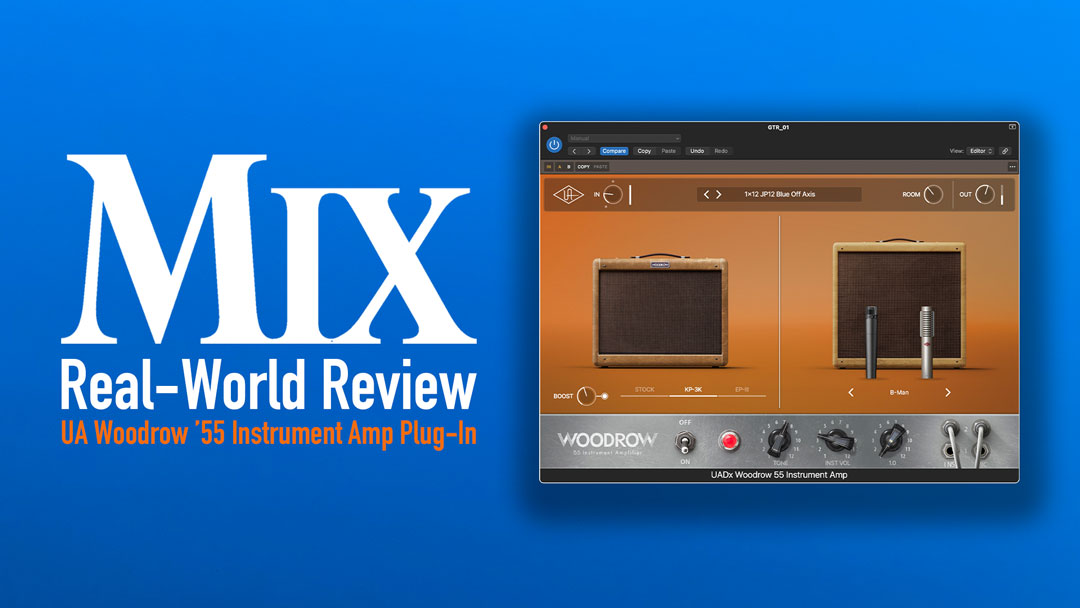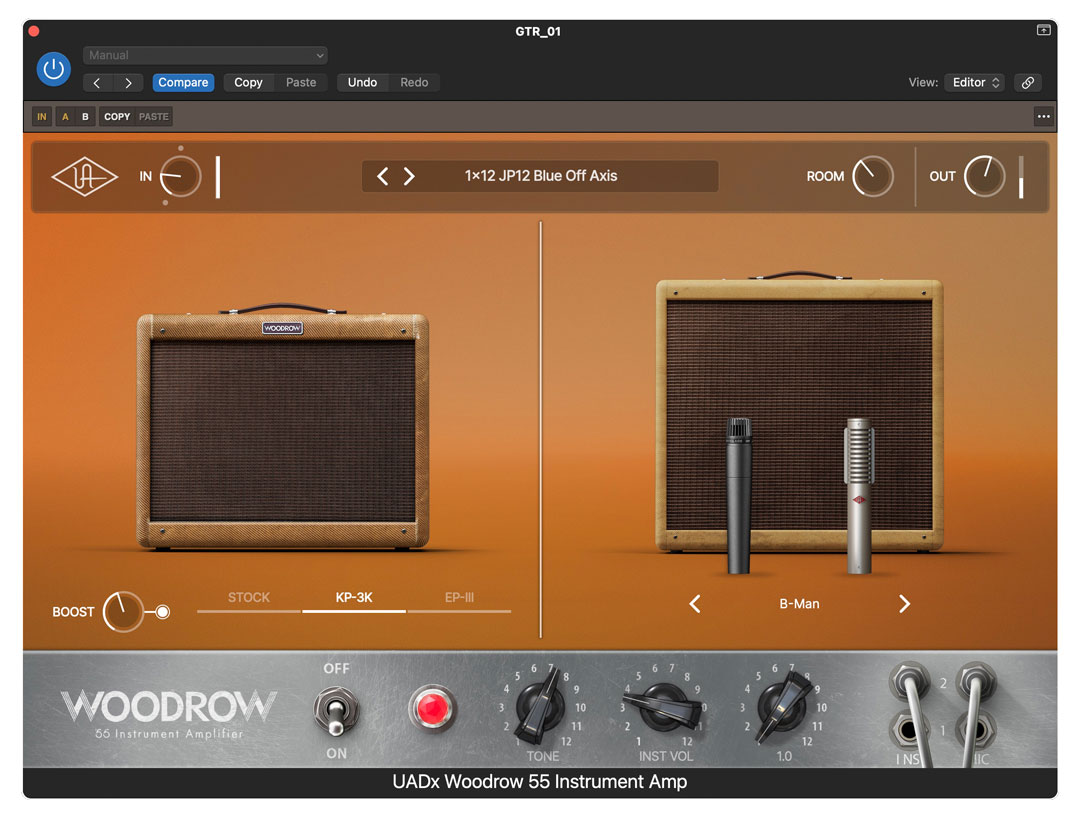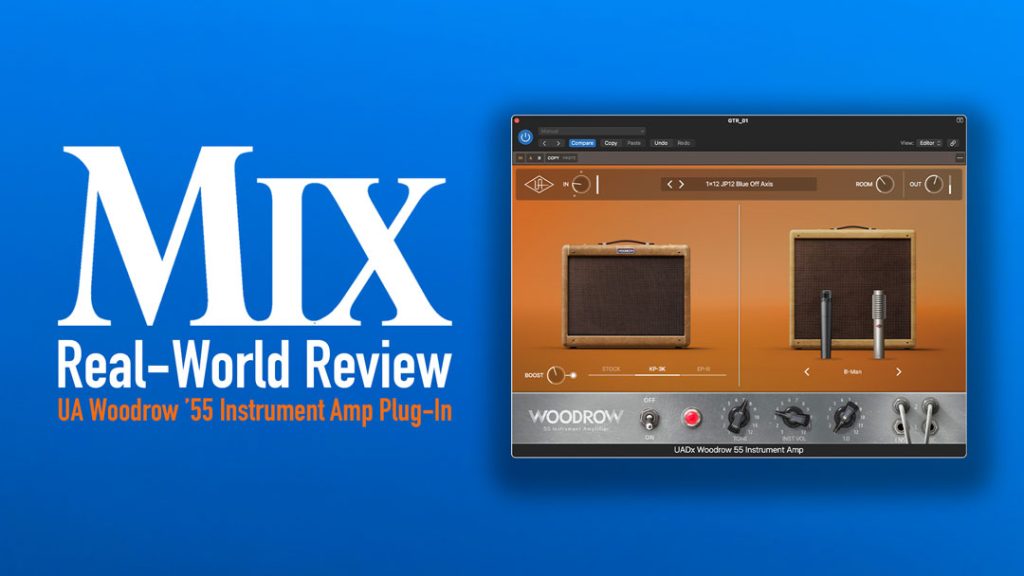
| MIX VERDICT: UA WOODROW ’55 INSTRUMENT AMPLIFIER PLUG-IN |
| THE TAKEAWAY: “I love the sound of this plug-in. I used it with tracks recorded with a Strat and a Tele, both rhythm and lead parts, and found excellent tones quickly.” |
| COMPANY: Universal Audio • www.uaudio.com PRICE: $199 PROS: • Warm-sounding emulation of a classic amp. • Excellent clean, crunchy and overdriven sounds. • Boost circuit offers three preamp flavors. • Instrument and Mic volume controls let you mix and match channel sounds. • Multiple cabinet emulations. • Direct option. CONS: • Mic configurations on cabinet models are fixed. |
New York, NY (July 10, 2025)—For years, Universal Audio has released impressive plug-in versions of its digitally modeled amp pedals, each emulating a classic guitar amp. The latest plug-in in the series is Woodrow ’55 Instrument Amplifier, which, like the company’s Woodrow ’55 Instrument Amplifier Pedal, released in 2022, seems to be based on a 1955 Fender Tweed Deluxe featuring the vaunted 5E3 circuit.
If you’re familiar with any of the other plug-ins in the series—the Dream ’65 Reverb Amp, Ruby ’63 Top Boost Amplifier and Lion ’68 Super Lead Amp—you’ll feel right at home with Woodrow ’55, which provides a similar user interface.

KNOBS AND SWITCHES
As with the amp it’s based on, Woodrow ’55 features knobs for Tone, Instrument Volume and Mic Volume. There are four inputs—Instrument 1 and 2, and Mic 1 and 2—offered in two pairs: Instrument 1/Mic 1 and Instrument 2/Mic 2. The former features more gain and brightness, the latter is cleaner and rounder.
You can use the Instrument Volume and Mic Volume knobs to isolate a single input if you like. For example, if you want to hear only Instrument Input 2, choose the Instrument 2/Mic 2 pair and turn down the Mic Volume knob. For both volume knobs, higher settings create more gain. A switchable Boost circuit provides additional control over gain and offers three options: Stock, KP-3K and EP-111. The latter two feature preamps modeled from other devices: KP-3K is from a digital delay from the 1980s, and the EP-III from a classic tape echo. Each has its own flavor and, in conjunction with the Boost knob, can add significant gain to your signal.
Peluso P-24 Microphone — A Mix Real-World Review
The plug-in also provides Input and Output control knobs that reside before and after the modeling section, respectively, and each has a meter. According to the manual, the primary purpose of the Input is to adjust for the level coming into the plug-in. For example, let’s say you’re applying the plugin to a track that was recorded really hot. You can turn the input down to compensate. However, the higher you set it, the more you drive the amp. Turning it up—especially above 0 dB—adds more oomph. But the clipping sounds less pleasant if pushed too far.
IN THE TWEEDS
The other significant sonic variables are the cabinet/mic combinations, which are preset but switchable. Six cabinets are provided, including four 1×12 options, a 4×10 and a 4×12. Each cabinet has a mic configuration featuring one or two classic microphones. Unlike some amp emulations, you can’t swap the mics or move their position. That would have been nice, but there’s something to be said for keeping it simple.
Each cabinet setting has a unique sound, and the fixed nature of cabinet/mic presets speeds up finding the tone you want by keeping the number of variables low. Another option, Direct, gives you the amp sound without a cabinet model. There’s no reverb or delay with this plug-in, but you can always insert those after the plug-in in your DAW. Similar to some of the other UA amp models, there is a Room knob that adds authentic room ambience.
Discover more insightful reviews—get a free Mix SmartBrief subscription!
It’s a UA plug-in, so you get a nice set of presets in a well-organized browser that lets you search by keyword.
DELUXE SOUNDS
I love the sound of this plug-in. I used it with tracks recorded with a Strat and a Tele, both rhythm and lead parts, and found excellent tones quickly. The various channel-level combinations, boost options and cabinet/mic choices provide both variety and sonic control. It has a versatile palette, ranging from clean to crunchy to heavily overdriven, and it exudes warmth wherever you set it. The sound is always authentic and has an intangible sweetness to it. I’ve used (and reviewed) many amp/cabinet simulations, and this one is right up there with my favorites. I like the others in the series, but Woodrow ’55 Instrument Amplifier would be my choice if I had to pick one of them.

